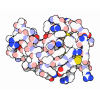[English] 日本語
 Yorodumi
Yorodumi- PDB-7cn7: T4 phage spackle protein gp61.3 complex with lysozyme domain of g... -
+ Open data
Open data
- Basic information
Basic information
| Entry | Database: PDB / ID: 7cn7 | |||||||||
|---|---|---|---|---|---|---|---|---|---|---|
| Title | T4 phage spackle protein gp61.3 complex with lysozyme domain of gp5 tail lysozyme | |||||||||
 Components Components |
| |||||||||
 Keywords Keywords | VIRAL PROTEIN / Lysozyme inhibitor complex / Phage / Lysis inhibition | |||||||||
| Function / homology |  Function and homology information Function and homology informationsuperinfection exclusion / host cell periplasmic space / symbiont entry into host cell via disruption of host cell wall peptidoglycan / virus tail, baseplate / viral tail assembly / symbiont entry into host cell via disruption of host cell envelope / virus tail / symbiont entry into host / peptidoglycan catabolic process / cell wall macromolecule catabolic process ...superinfection exclusion / host cell periplasmic space / symbiont entry into host cell via disruption of host cell wall peptidoglycan / virus tail, baseplate / viral tail assembly / symbiont entry into host cell via disruption of host cell envelope / virus tail / symbiont entry into host / peptidoglycan catabolic process / cell wall macromolecule catabolic process / lysozyme / lysozyme activity / killing of cells of another organism / defense response to bacterium / symbiont entry into host cell / identical protein binding Similarity search - Function | |||||||||
| Biological species |  Enterobacteria phage T4 (virus) Enterobacteria phage T4 (virus) | |||||||||
| Method |  X-RAY DIFFRACTION / X-RAY DIFFRACTION /  SYNCHROTRON / SYNCHROTRON /  MOLECULAR REPLACEMENT / Resolution: 1.15 Å MOLECULAR REPLACEMENT / Resolution: 1.15 Å | |||||||||
 Authors Authors | Kanamaru, S. / Leiman, P.G. | |||||||||
| Funding support |  Japan, 2items Japan, 2items
| |||||||||
 Citation Citation |  Journal: Viruses / Year: 2020 Journal: Viruses / Year: 2020Title: Structure and Function of the T4 Spackle Protein Gp61.3. Authors: Kanamaru, S. / Uchida, K. / Nemoto, M. / Fraser, A. / Arisaka, F. / Leiman, P.G. | |||||||||
| History |
|
- Structure visualization
Structure visualization
| Structure viewer | Molecule:  Molmil Molmil Jmol/JSmol Jmol/JSmol |
|---|
- Downloads & links
Downloads & links
- Download
Download
| PDBx/mmCIF format |  7cn7.cif.gz 7cn7.cif.gz | 229.8 KB | Display |  PDBx/mmCIF format PDBx/mmCIF format |
|---|---|---|---|---|
| PDB format |  pdb7cn7.ent.gz pdb7cn7.ent.gz | 153.7 KB | Display |  PDB format PDB format |
| PDBx/mmJSON format |  7cn7.json.gz 7cn7.json.gz | Tree view |  PDBx/mmJSON format PDBx/mmJSON format | |
| Others |  Other downloads Other downloads |
-Validation report
| Summary document |  7cn7_validation.pdf.gz 7cn7_validation.pdf.gz | 707.2 KB | Display |  wwPDB validaton report wwPDB validaton report |
|---|---|---|---|---|
| Full document |  7cn7_full_validation.pdf.gz 7cn7_full_validation.pdf.gz | 709.3 KB | Display | |
| Data in XML |  7cn7_validation.xml.gz 7cn7_validation.xml.gz | 16.4 KB | Display | |
| Data in CIF |  7cn7_validation.cif.gz 7cn7_validation.cif.gz | 24.9 KB | Display | |
| Arichive directory |  https://data.pdbj.org/pub/pdb/validation_reports/cn/7cn7 https://data.pdbj.org/pub/pdb/validation_reports/cn/7cn7 ftp://data.pdbj.org/pub/pdb/validation_reports/cn/7cn7 ftp://data.pdbj.org/pub/pdb/validation_reports/cn/7cn7 | HTTPS FTP |
-Related structure data
| Related structure data |  7cn6C  1k28S S: Starting model for refinement C: citing same article ( |
|---|---|
| Similar structure data |
- Links
Links
- Assembly
Assembly
| Deposited unit | 
| ||||||||||||
|---|---|---|---|---|---|---|---|---|---|---|---|---|---|
| 1 |
| ||||||||||||
| Unit cell |
|
- Components
Components
-Protein , 2 types, 2 molecules AC
| #1: Protein | Mass: 20353.336 Da / Num. of mol.: 1 Source method: isolated from a genetically manipulated source Details: SF file contains Friedel pairs. / Source: (gene. exp.)  Enterobacteria phage T4 (virus) / Plasmid: pUC19 / Production host: Enterobacteria phage T4 (virus) / Plasmid: pUC19 / Production host:  |
|---|---|
| #2: Protein | Mass: 8688.785 Da / Num. of mol.: 1 Source method: isolated from a genetically manipulated source Source: (gene. exp.)  Enterobacteria phage T4 (virus) / Gene: sp, 61.3 / Plasmid: pUC19 / Production host: Enterobacteria phage T4 (virus) / Gene: sp, 61.3 / Plasmid: pUC19 / Production host:  |
-Non-polymers , 5 types, 384 molecules 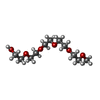








| #3: Chemical | ChemComp-1PG / | ||||||
|---|---|---|---|---|---|---|---|
| #4: Chemical | ChemComp-EDO / #5: Chemical | #6: Chemical | ChemComp-CL / | #7: Water | ChemComp-HOH / | |
-Details
| Has ligand of interest | N |
|---|---|
| Has protein modification | Y |
-Experimental details
-Experiment
| Experiment | Method:  X-RAY DIFFRACTION / Number of used crystals: 1 X-RAY DIFFRACTION / Number of used crystals: 1 |
|---|
- Sample preparation
Sample preparation
| Crystal | Density Matthews: 2.33 Å3/Da / Density % sol: 47.26 % |
|---|---|
| Crystal grow | Temperature: 293.15 K / Method: vapor diffusion, hanging drop / pH: 6.4 / Details: PEG550MME, MES, KSCN |
-Data collection
| Diffraction | Mean temperature: 100 K / Serial crystal experiment: N |
|---|---|
| Diffraction source | Source:  SYNCHROTRON / Site: SYNCHROTRON / Site:  SLS SLS  / Beamline: X06DA / Wavelength: 1 Å / Beamline: X06DA / Wavelength: 1 Å |
| Detector | Type: MARMOSAIC 225 mm CCD / Detector: CCD / Date: Sep 3, 2011 |
| Radiation | Protocol: SINGLE WAVELENGTH / Monochromatic (M) / Laue (L): M / Scattering type: x-ray |
| Radiation wavelength | Wavelength: 1 Å / Relative weight: 1 |
| Reflection | Resolution: 1.15→46.72 Å / Num. obs: 187608 / % possible obs: 99.8 % / Redundancy: 7.1 % / Biso Wilson estimate: 10.29 Å2 / CC1/2: 1 / Rmerge(I) obs: 0.044 / Rpim(I) all: 0.018 / Rrim(I) all: 0.047 / Χ2: 1.01 / Net I/σ(I): 24.5 |
| Reflection shell | Resolution: 1.15→1.17 Å / Redundancy: 6.3 % / Rmerge(I) obs: 0.542 / Mean I/σ(I) obs: 0.859 / Num. unique obs: 4655 / CC1/2: 0.859 / Rpim(I) all: 0.23 / Rrim(I) all: 0.59 / Χ2: 1.01 / % possible all: 97.6 |
- Processing
Processing
| Software |
| |||||||||||||||||||||||||||||||||||||||||||||||||||||||||||||||||||||||||||||||||||||||||||||||||||||||||||||||||||||||||||||||||||||||||||||||||||||||||||||||||||||||||||||||||||||||||||||||||||||||||||||||||||||||||
|---|---|---|---|---|---|---|---|---|---|---|---|---|---|---|---|---|---|---|---|---|---|---|---|---|---|---|---|---|---|---|---|---|---|---|---|---|---|---|---|---|---|---|---|---|---|---|---|---|---|---|---|---|---|---|---|---|---|---|---|---|---|---|---|---|---|---|---|---|---|---|---|---|---|---|---|---|---|---|---|---|---|---|---|---|---|---|---|---|---|---|---|---|---|---|---|---|---|---|---|---|---|---|---|---|---|---|---|---|---|---|---|---|---|---|---|---|---|---|---|---|---|---|---|---|---|---|---|---|---|---|---|---|---|---|---|---|---|---|---|---|---|---|---|---|---|---|---|---|---|---|---|---|---|---|---|---|---|---|---|---|---|---|---|---|---|---|---|---|---|---|---|---|---|---|---|---|---|---|---|---|---|---|---|---|---|---|---|---|---|---|---|---|---|---|---|---|---|---|---|---|---|---|---|---|---|---|---|---|---|---|---|---|---|---|---|---|---|---|
| Refinement | Method to determine structure:  MOLECULAR REPLACEMENT MOLECULAR REPLACEMENTStarting model: 1k28 Resolution: 1.15→17.92 Å / SU ML: 0.0849 / Cross valid method: FREE R-VALUE / σ(F): 1 / Phase error: 10.4462 Stereochemistry target values: GeoStd + Monomer Library + CDL v1.2
| |||||||||||||||||||||||||||||||||||||||||||||||||||||||||||||||||||||||||||||||||||||||||||||||||||||||||||||||||||||||||||||||||||||||||||||||||||||||||||||||||||||||||||||||||||||||||||||||||||||||||||||||||||||||||
| Solvent computation | Shrinkage radii: 0.9 Å / VDW probe radii: 1.11 Å / Solvent model: FLAT BULK SOLVENT MODEL | |||||||||||||||||||||||||||||||||||||||||||||||||||||||||||||||||||||||||||||||||||||||||||||||||||||||||||||||||||||||||||||||||||||||||||||||||||||||||||||||||||||||||||||||||||||||||||||||||||||||||||||||||||||||||
| Displacement parameters | Biso mean: 16.28 Å2 | |||||||||||||||||||||||||||||||||||||||||||||||||||||||||||||||||||||||||||||||||||||||||||||||||||||||||||||||||||||||||||||||||||||||||||||||||||||||||||||||||||||||||||||||||||||||||||||||||||||||||||||||||||||||||
| Refinement step | Cycle: LAST / Resolution: 1.15→17.92 Å
| |||||||||||||||||||||||||||||||||||||||||||||||||||||||||||||||||||||||||||||||||||||||||||||||||||||||||||||||||||||||||||||||||||||||||||||||||||||||||||||||||||||||||||||||||||||||||||||||||||||||||||||||||||||||||
| Refine LS restraints |
| |||||||||||||||||||||||||||||||||||||||||||||||||||||||||||||||||||||||||||||||||||||||||||||||||||||||||||||||||||||||||||||||||||||||||||||||||||||||||||||||||||||||||||||||||||||||||||||||||||||||||||||||||||||||||
| LS refinement shell |
|
 Movie
Movie Controller
Controller



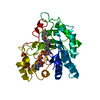
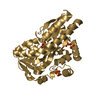


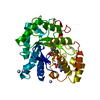
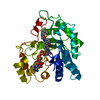
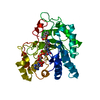

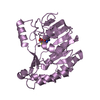
 PDBj
PDBj
